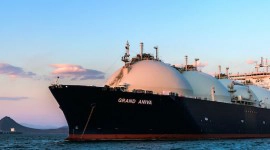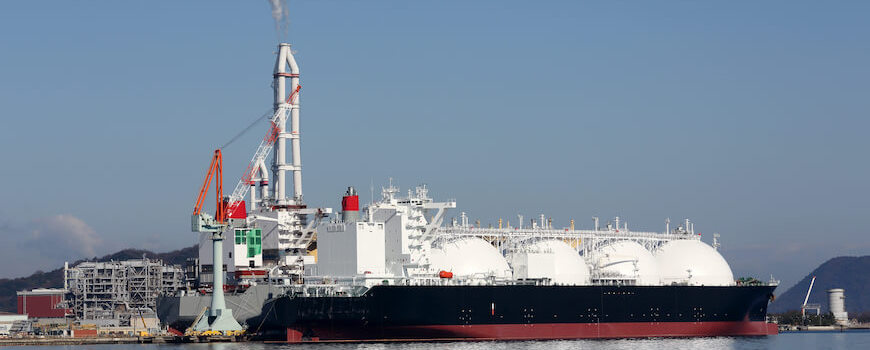
Natural gas is one of the most important energy sources in the world. As we wrote in our article on natural gas, gas is mainly transported through international pipelines.
It is the international trade in natural gas and the pipeline network that brought LNG to life. In this article, you can read about what LNG means, how liquefied natural gas is produced, how it is stored, and how it is used.
What is LNG?
LNG stands for “liquefied natural gas”. It has almost the same composition as natural gas in the traditional sense – only in refrigerated form. This means that it has a temperature of -162 ° C and its density is lower than water’s.
The essential difference compared to natural gas transported by pipeline is that at storage temperature certain components (water, hydrocarbons, carbon dioxide, mercury) freeze to solid: they must be extracted almost completely from the liquefied gas. Other than that, everything else is the same as in the case of natural gas transported by pipeline in a gaseous state. LNG is colourless and odourless, non-toxic, but extremely flammable.
Due to the latter property, LNG is also odorized. Tetrahydrothiophene or ethyl mercaptan are most commonly used for odour. If it is not odorized, it is monitored with gas sensors.
Natural gas is usually transported in its liquefied state when transport by pipeline is not feasible. For example, in regions that are too far from the gas extraction sites and thus there is no connecting pipeline, but where the conditions for road transport and water transport are given. In this case, instead of pipelines, they are delivered on cargo ships, as LNG can be transported extremely well and efficiently at sea. One cubic meter of liquefied LNG – after regasification – produces about 600 cubic meters of natural gas in normal condition.
How the natural gas is produced has already been discussed in the above-mentioned article. But how will the gas become liquefied?
Production of LNG
Liquefied natural gas can be produced by several different processes, but each process has the same essence: compressing and cooling the gas. The most common processes are the following:
- APCI or C3MR method
- DMR
- Linde
- Cascade procedure
APCI or C3MR is the most common amongst these processes.
APCI is a liquefaction process that bears the name of the development company (Air Products and Chemicals Inc.). There are two main cooling cycles in this technology. The first cycle consists of a multi-stage propane (C3) precooling system followed by a liquefaction cycle using an MR system consisting of nitrogen, methane, ethane, and propane. The heart of the APCI-C3MR process is a proprietary spiral-wound heat exchanger (SWHE) with a thermal efficiency of over 93%.
In addition to this technology, several large oil and gas companies have developed their own process (such as Shell or Linde), yet the APCI method is used by most.
The other commonly used technology is the DMR (dual mixed refrigerant), which, while very similar to the APCI process, uses a dual system (two mechanically driven compressors) instead of a single-component refrigerant.
LNG storage and transportation
It is important to know that -162 ° C is the boiling point of LNG – which is an extremely low temperature compared to terrestrial conditions. This is mainly the reason why liquefied natural gas requires very careful control.
Storage requires heat-insulated steel tanks that, on the one hand, can withstand extreme temperatures of -162 ° C and, on the other hand, can maintain this internal temperature without any external cooling. This requires special thermal insulation, which in many cases cannot be solved (for example, in some port storage facilities). In these cases, mechanical coolers are used, or the gas phase of the tank is tapped to keep the temperature of the liquefied gas in the tank.
However, it is important to know that LNG has an energy density per unit volume of more than three times that of CNG (compressed natural gas). This difference between LNG and CNG means that LNG can be stored and used more efficiently even with the weight of its tank.
Natural gas is transported in the form of LNG over a distance of 3-4000 km on land and over 1000-1500 km in the deep sea. Below these distances, it is more economical to deliver the natural gas in its original state, on the transmission pipeline system to the designated location. However, if the distance is longer, the loss due to transport or pressure maintenance of the line may be too great.
It is then usually transported directly by tankers developed for this purpose, which should be imagined as the monster shown in the picture.

During transport, the liquefied natural gas is finally transported to a location from which it can be transported via pipelines to the designated destination via “re-gasification”.
The biggest importers of LNG are:
- Great Britain
- Spain
- Japan
- South Korea
- China
- Taiwan
- India
The biggest exporter is Qatar.
What is LNG used for?
As the composition of LNG is very similar, but not 100% identical to that of gaseous natural gas, the quality, and composition of LNG is strictly controlled. This is not surprising, as the composition is a very important factor in the price of liquefied natural gas because it greatly influences the calorific value of natural gas.
Safety is also paramount, as when LNG reaches the end-user country, it generates extremely high energy concentrations in the tanks. A possible leak or accidental explosion would cause enormous natural damage, as the methane in it that would enter the air is much more harmful than, for example, carbon dioxide.
Fortunately, there has been no occurrence of a major accident during the fifty years of using LNG. No wonder, as the bins are made of extra quality steel. In addition, the system's fittings and other safety features prevent larger amounts of gas from escaping.
And if for some reason, the gas were to leak or leave the storage tank, a torch used for this purpose would immediately burn the waste gases, safely and completely.
The use of LNG is the same as that of non-liquefied gas.
Conclusion
LNG is an abbreviation of liquefied natural gas. It is usually used when natural gas has to be transported over too long distances or when there is no international pipeline network between the exporter and the importer. One cubic meter of liquefied LNG – after re-gasification – produces about 600 cubic meters of natural gas in normal condition.
The composition of liquefied natural gas is almost identical to that of natural gas delivered by pipeline in the gaseous state. The only difference is that because it is cooled to a temperature of -162 ° C, some of its components freeze to solid. These are extracted to such an extent that they will only be found in traces in LNG. The production of liquefied gas is mostly done by the APCI or C3MR method.
The largest importer of LNG is Japan, while the largest exporter is Qatar.
